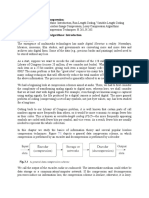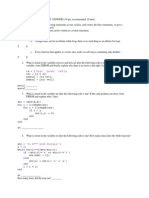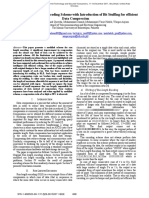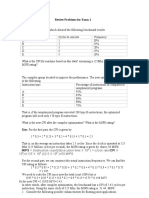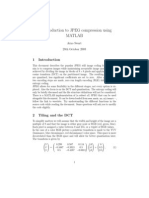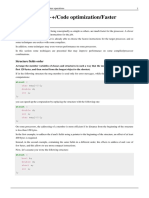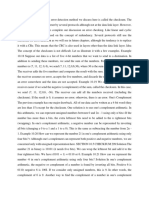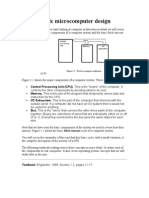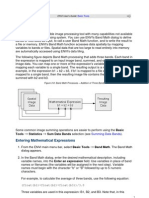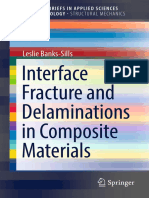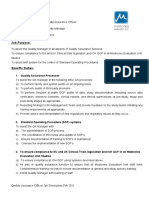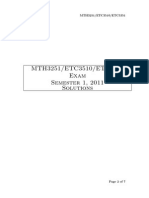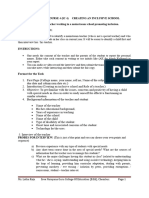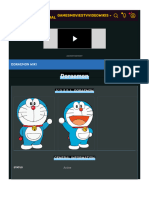Digital Data Compression
Digital Data Compression
Uploaded by
Jeff WebberCopyright:
Available Formats
Digital Data Compression
Digital Data Compression
Uploaded by
Jeff WebberCopyright
Available Formats
Share this document
Did you find this document useful?
Is this content inappropriate?
Copyright:
Available Formats
Digital Data Compression
Digital Data Compression
Uploaded by
Jeff WebberCopyright:
Available Formats
LET'S GET TECHNICAL (Article from October 2004) Shrinking Bits: A Second Look at Digital Data Compression James
L. Antonakos Last time we examined the applications for lossless and lossy data compression methods. In this second look at digital data compression, we will take a look inside these different compression techniques: Run Length Encoding Dictionary-Based Compression Huffman Coding Shannon-Fano Coding Quantization
All of these techniques provide lossless compression except for the Quantization, which throws away information and achieve higher compression ratios. Let us begin with Run Length Encoding. Run-Length Encoding (RLE) is one of the most simplest compression schemes available. In this technique, a single data value and a repeat count replace consecutive data values that have the same value. Figure 1 shows a simple example. Here, 20 bytes of input data are compressed into 12 bytes of output data. The more the data values stay the same, the greater the compression. For example, if 255 bytes of data all contain the same value, the RLE data will consist of only two bytes (repeat count and data value).
Figure 1: Using run-length encoding to compress data Dictionary-based compression involves building a dictionary of the words (or phrases) used in the text to be compressed. Pointers to the words within the dictionary represent the words from the input text. Frequently used words are only stored once in the dictionary, which is where the compression comes in. Figure 2 illustrates this compression process.
Figure 2: Operation of the word-based dictionary compression process Let us work through an example. Consider the following block of text (which is contained within the input file): 2
The wheels on the bus go round and round round and round round and round. The wheels on the bus go round and round all day long. This text contains 138 bytes of data (uncompressed) when saved as an ordinary text file. Do not forget that the newline characters (carriage return, line feed) at the end of each line must also be counted, as well as the spaces between words. The word dictionary created for this input data contains the entries shown in Table 1. Word Number 1 2 3 4 5 6 7 8 9 10 11 12 13 Word The wheels on the bus go<cr> round and round<cr> round. all day long. Total Length Length 4 7 3 4 4 3 6 4 6 7 4 4 6 62
Table 1: Word dictionary created from input text file The pointers to the words in the dictionary will be saved as 16-bit (two byte) integers. This allows for 65,535 different words in the dictionary. The pointer stream for the input text looks like this: 1 7 7 7 1 7 11 0 2 8 8 8 2 8 12 3 9 9 10 3 9 13 4 5 6
The 0 pointer at the end indicates the end of the pointer stream. This gives a total of 28 pointers, which require 56 bytes of storage in the output file. Together with the 62 bytes of dictionary text, the output file contains a total of 118 bytes. This is not much of a savings compared to the original 138 bytes of uncompressed data. If, however, the words were longer or occurred more frequently, 3
better compression would result. Let us see if this is true by extending words into phrases. Table 2 lists the phrases found in the input file. Phrase Number 1 2 3 4 Phrase The wheels on the bus go round and round round and round. all day long. Total Length Length 25 16 17 14 72
Table 2: Phrase dictionary created from input text The pointer stream for the phrases becomes: 1 2 2 3 1 2 4 0 Now, we only need to store eight phrase pointers, for a total of 16 bytes. Together with the 72 bytes of phrase dictionary we have an output file containing 88 bytes of compressed data, a much larger savings than the word-based method. Both RLE and dictionary compression do their work on-the-fly. Other compression techniques look at the entire block of data before beginning their work. These compression techniques fall into the Statistical category of compression methods. The first technique in this category is Huffman coding. In this technique, we build unique binary strings to represent the different data items we encounter. The binary strings typically require fewer bits to store than the original data item. Huffman coding begins with information that describes the distribution of different data items within the entire block of data. For example, suppose we have a text file containing 250,000 characters, all of which are either A, B, C, or D, with the percentages shown in Table 3. Character Percentage A 50% B 10% C 15% D 25%
Table 3: Distribution of data items within input file Huffman coding begins by finding the two smallest percentage items (the B and C characters) and combining them into a simple tree structure. The combined percentage (10% plus 15% equals 25%) is now placed back into the list of percentages and the process is repeated until you get to 100%. The data items are placed into the structure so that the lower percentage item is always on the left. Figure 3 shows the tree structure generated using the Huffman technique.
Figure 3: Tree structure containing unique binary strings for each data item. By traversing the tree, we can determine the unique binary strings associated with each data item. Table 4 shows the results of the traversal. Data Item A B C D Percentage 50% 10% 15% 25% Bit String 0 110 111 10
Table 4: Huffman coding strings for the four data items Notice that the data items with the largest percentages have the smallest bit strings. This is the beauty of Huffman coding. Knowing the lengths of each bit string, we can easily determine the average number of bits per character required in the compressed file. Table 5 shows the calculations. Data Item A B C D Bit String 0 110 111 10 Bit Length Percentage 1 3 3 2 50% 10% 15% 25% Total Bits Required 0.5 0.3 0.45 0.5 1.75
Table 5: Calculations to determine average number of bits per compressed character
Multiplying each percentage by its associated bit string length and adding them up gives a total of 1.75 bits per compressed character. In the original data file, each character required eight bits of storage for a total of 2,000,000 bits. Now only 437,500 bits are needed (250,000 characters times 1.75 bits/character), plus a few bits to store the unique strings table and associated data items. You can experiment with Huffman coding through a simple MSDOS program called HUFF, available for download at http://www.sunybroome.edu/~antonakos_j/nutsvolts/huff.exe A sample execution of HUFF for the previous example is shown in Figure 4.
Figure 4: Sample execution of HUFF program 6
The percentages on the MSDOS command line represent, in order, the As, Bs, Cs, and Ds and must add up to 100%. The Shannon-Fano coding technique also uses the list of percentages to determine unique bit strings for the individual data items. Instead of building a tree structure, the Shannon-Fano technique simply breaks down the data items into different groups of items, assigning a bit value to each group. First, the items are arranged in descending order of percentage, as shown in Table 6. Data Item A D C B Percentage 50% 25% 15% 10%
Table 6: Percentages sorted into descending order Next, divide the items into two groups so that each group has roughly the same percentage as the other. One group gets a 0 bit assigned to it and the other group gets a 1 bit. Keep subdividing the groups until there are no more groups to split. Figure 5 illustrates this process.
(a) (b) Figure 5: Partitioning the data items in Shannon-Fano coding (a) Finding the first two groups (A and DCB) (b) Splitting the DCB group (into D and CB) (c) Splitting the CB group
(c)
The unique bits strings for each data item are easily read off Figure 5(c). Note the similarities with the strings from the Huffman coding example. Are the results the same? If not, are they acceptable? The answers are Not exactly and sure they are! Last, we come to our only lossless technique, buried within the compression algorithm for JPG images, and indicated in the flowchart shown in Figure 6.
Figure 6: Steps involved in compressing one 8-by-8 block of pixels in a JPG image The compression in a JPG comes from the combination of a Quantizing process followed by RLE compression. An algorithm called the Discrete Cosine Transform (DCT) is used on an 8-by-8 block of pixels from the original image, converting the 64 data values in the block to another set of 8-by-8 DCT values. These new values do not represent pixel colors or intensities any longer. Instead, they represent frequency information caused by the interaction of the pixels. If a reverse DCT is used on the converted data you would get the original pixels back. Instead, the Quantizing process divides all the DCT values by an integer, throwing away the remainders. For example, the following string of data is quantized by dividing all values by 10 and ignoring the remainders: Input: Output: 212 21 186 18 112 11 67 6 36 3 18 1 11 1 4 0
Now, when the quantized data is un-quantized (multiplied by 10), we get: 8
Input: Output:
21 210
18 180
11 110
6 60
3 30
1 10
1 10
0 0
Let us compare the original eight data values with their un-quantized values: Original: 212 Un-quantized: 210 186 180 112 110 67 60 36 30 18 10 11 10 4 0
They are all different. Lossy compression does not give us our original data back. But in the case of the JPG image, this does not matter. The un-quantized values will be passed through the reverse DCT process, giving an 8-by-8 block of pixels that are close to the original block of pixels but slightly different. What, only 30 shades of blue instead of 243? Our eye is not good enough to notice subtle changes in color, which is why we can get away with lossy compression (via quantization) in the JPG image. Plus, best of all, by throwing away the remainders, the quantized data compresses better. The nature of the DCT is to create values similar to those shown in the example. However, the DCT values get smaller in each new row of the 8-by-8 matrix, which leads to many 0s and other small integers clustering near the bottom right corner of the matrix. By using a Zig-Zag technique to read the quantized values out one diagonal at a time, we create a 64 element string of quantized values with many duplicated values grouped together. RLE compression then compacts the string by eliminating the duplicates. The process shown in Figure 6 must be repested for every 8-by-8 block of pixels in the image. An image having a resolution of 640 by 480 would contain 4800 blocks of pixels. The DCT process alone would require over 2.4 million multiplications for all pixel blocks. Just seeing a JPG image appear in a browser is a feat of mathematical engineering. There are many other compression methods, some of which are listed in Table 7. Compression Technique Lempel-Ziv-Welch (LZW) Adaptive Huffman Delta Modulation Category and Type Lossless, dictionary Lossless, statistical Lossy via quantization Application TIF image files Large files Speech compression
Table 7: Additional compression techniques Some techniques are easily performed in hardware while others are easily applied using hardware. Even inexpensive digital cameras have hardware to compress the image data. Search the web for additional compression information and techniques, and be prepared to compress the results you get from the volume of information out there.
James Antonakos is a Professor in the Departments of Electrical Engineering Technology and Computer Studies at Broome Community College, with over 28 years of experience designing digital and analog circuitry and developing software. He is also the author of numerous textbooks on microprocessors, programming, and microcomputer systems. You may reach him at antonakos_j@sunybroome.edu or visit his web site at http://www.sunybroome.edu/~antonakos_j.
10
You might also like
- SPSS Case AnalysisDocument10 pagesSPSS Case AnalysisJeremiah GarciaNo ratings yet
- Computer Science Extended EssayDocument15 pagesComputer Science Extended EssayMonkey D LuffyNo ratings yet
- IOSH Managing Safely A5 - Sep10Document6 pagesIOSH Managing Safely A5 - Sep10subodhdayal67% (3)
- 6.1 Lossless Compression Algorithms: Introduction: Unit 6: Multimedia Data CompressionDocument25 pages6.1 Lossless Compression Algorithms: Introduction: Unit 6: Multimedia Data CompressionSameer ShirhattimathNo ratings yet
- Chap 10Document33 pagesChap 10Hàng Không Mẫu HạmNo ratings yet
- Speech CompresionDocument22 pagesSpeech Compresionmelazem rymNo ratings yet
- Main Techniques and Performance of Each CompressionDocument23 pagesMain Techniques and Performance of Each CompressionRizki AzkaNo ratings yet
- Reducing Lookup Table Size Used For Bit-Counting AlgorithmDocument8 pagesReducing Lookup Table Size Used For Bit-Counting AlgorithmOsvaldo NavarroNo ratings yet
- Assignment 5: Raw Memory: Bits and BytesDocument6 pagesAssignment 5: Raw Memory: Bits and BytesnikNo ratings yet
- 'Blue' 'Green' 'Red': For For If End End EndDocument4 pages'Blue' 'Green' 'Red': For For If End End Endnael94No ratings yet
- SampleExamSolutions 2upDocument7 pagesSampleExamSolutions 2upspikysimNo ratings yet
- Chap15 1473751047 598113Document34 pagesChap15 1473751047 598113hungnnhe187018No ratings yet
- Instructions: Csce 212: Final Exam Spring 2009Document5 pagesInstructions: Csce 212: Final Exam Spring 2009NapsterNo ratings yet
- ITec2036 Computer Architecture and Organization AssementDocument17 pagesITec2036 Computer Architecture and Organization Assementbamlakalemayew7No ratings yet
- Chapter 10 CompressionDocument66 pagesChapter 10 CompressionSandhya PandeyNo ratings yet
- Algorithms For Data Compression in Wireless Computing SystemsDocument7 pagesAlgorithms For Data Compression in Wireless Computing Systemsnikhilvbhatt9591No ratings yet
- Chapter 2 FinalDocument26 pagesChapter 2 FinalRami ReddyNo ratings yet
- The BCS Professional Examination Certificate April 2005 Examiners' ReportDocument17 pagesThe BCS Professional Examination Certificate April 2005 Examiners' ReportOzioma IhekwoabaNo ratings yet
- Lemp El Ziv ReportDocument17 pagesLemp El Ziv ReportJohn Lester Cruz EstarezNo ratings yet
- Nen AnhDocument36 pagesNen Anhsơn trầnNo ratings yet
- CIS 5100 Homework Assignment #2: Fall 2020, Dr. Song Xing Due On Monday, Oct 5Document6 pagesCIS 5100 Homework Assignment #2: Fall 2020, Dr. Song Xing Due On Monday, Oct 5Oliver BaileyNo ratings yet
- Digital RPTDocument12 pagesDigital RPTDexter FengNo ratings yet
- P2 - Image RLEDocument4 pagesP2 - Image RLEJames CNo ratings yet
- Data Compression Btech NotesDocument32 pagesData Compression Btech NotesHarsh RaiNo ratings yet
- Modified Run Length Encoding Scheme With Introduction of Bit Stuffing For Efficient Data CompressionDocument5 pagesModified Run Length Encoding Scheme With Introduction of Bit Stuffing For Efficient Data CompressionAnkit SmithNo ratings yet
- 8b 10b Encode DecodeDocument5 pages8b 10b Encode DecodedebshubraNo ratings yet
- LZ SQUEEZER: A Compression Technique Based On LZ77 and LZ78Document4 pagesLZ SQUEEZER: A Compression Technique Based On LZ77 and LZ78thesijNo ratings yet
- Mini Project: Nutrition Calculator Calculate Nutrition For RecipesDocument20 pagesMini Project: Nutrition Calculator Calculate Nutrition For RecipesAbhinav aroraNo ratings yet
- Data CompressionDocument20 pagesData CompressionHimanshu PandayNo ratings yet
- Computing MikeDocument10 pagesComputing Mikemike.saundersNo ratings yet
- Z80 - Basic ConceptsDocument21 pagesZ80 - Basic ConceptsHaddouNo ratings yet
- Big Homework 2: General MentionsDocument11 pagesBig Homework 2: General MentionsCosti RăzvanNo ratings yet
- R TutorialDocument119 pagesR TutorialPrithwish GhoshNo ratings yet
- Multimedia Systems Chapter 7Document21 pagesMultimedia Systems Chapter 7sileshi alelignNo ratings yet
- Computer Science RevisionDocument73 pagesComputer Science Revisionashley chipwanyiraNo ratings yet
- Review Problems For Exam 1: MIPS (Instruction Count) / (Execution Time X 10Document6 pagesReview Problems For Exam 1: MIPS (Instruction Count) / (Execution Time X 10Erz SeNo ratings yet
- Parallel SortDocument7 pagesParallel SortzololuxyNo ratings yet
- Run Length EncodingDocument7 pagesRun Length EncodingfatimatumbiNo ratings yet
- Explain FLYNN Classification With Suitable ExamplesDocument7 pagesExplain FLYNN Classification With Suitable Examplesjishupanja33No ratings yet
- AQA-8525-TG-RLEDocument6 pagesAQA-8525-TG-RLEheoj4787No ratings yet
- ps1 PDFDocument5 pagesps1 PDFAnilNo ratings yet
- SPRING 2015 CDA 3101 Homework 3: Date-Assigned: Mar 27th, 2015 Due Dates: 11:55pm, April 7th, 2015Document5 pagesSPRING 2015 CDA 3101 Homework 3: Date-Assigned: Mar 27th, 2015 Due Dates: 11:55pm, April 7th, 2015ayylmao kekNo ratings yet
- An Introduction To JPEG Compression Using Matlab: Arno Swart 28th October 2003Document5 pagesAn Introduction To JPEG Compression Using Matlab: Arno Swart 28th October 2003Arini PartiwiNo ratings yet
- Optimizing C++/Code Optimization/faster Operations: Structure Fields OrderDocument5 pagesOptimizing C++/Code Optimization/faster Operations: Structure Fields OrderTukang UsilNo ratings yet
- Binary Image Compressi0n SchemesDocument8 pagesBinary Image Compressi0n SchemesMohammed Ahmed ShaikhNo ratings yet
- Mcs-012 Solved Assignment Ignou 2012Document28 pagesMcs-012 Solved Assignment Ignou 2012Jaimy Ranjith50% (2)
- Udacity Python CourseDocument22 pagesUdacity Python CourseRoll no.17 Shubham PatelNo ratings yet
- Cominication PDFDocument3 pagesCominication PDFatifNo ratings yet
- 15 Data Compression: Foundations of Computer Science Cengage LearningDocument33 pages15 Data Compression: Foundations of Computer Science Cengage LearningNitika TomarNo ratings yet
- Going From C To MIPS Assembly Basic Operations: Loops, ConditionalsDocument5 pagesGoing From C To MIPS Assembly Basic Operations: Loops, ConditionalsLilly Elissabett MoralesNo ratings yet
- Seminar Data CompressionDocument32 pagesSeminar Data CompressionekamkohliNo ratings yet
- Basic Microcomputer DesignDocument25 pagesBasic Microcomputer Designmhel_almoNo ratings yet
- Input: 1.1. AssignmentDocument6 pagesInput: 1.1. AssignmentHalifatulKameliaNo ratings yet
- Data Compression Algorithms and Their ApplicationsDocument14 pagesData Compression Algorithms and Their ApplicationsMohammad Hosseini100% (1)
- CH 15Document34 pagesCH 15LeoPhạmNo ratings yet
- Band MathDocument10 pagesBand MathcheirheynaldinhoNo ratings yet
- Chrome C-Ares Bug WriteupDocument42 pagesChrome C-Ares Bug Writeupddingo123No ratings yet
- Design and Implementation Af LZW Data Compression AlgorithmDocument11 pagesDesign and Implementation Af LZW Data Compression AlgorithmMandy DiazNo ratings yet
- AP Computer Science Principles: Student-Crafted Practice Tests For ExcellenceFrom EverandAP Computer Science Principles: Student-Crafted Practice Tests For ExcellenceNo ratings yet
- The Elements of Computing Systems, second edition: Building a Modern Computer from First PrinciplesFrom EverandThe Elements of Computing Systems, second edition: Building a Modern Computer from First PrinciplesNo ratings yet
- Engineering Management: Lecture by Prof. Dr. Naseer Ahmed Email: Naseer@cecos - Edu.pkDocument50 pagesEngineering Management: Lecture by Prof. Dr. Naseer Ahmed Email: Naseer@cecos - Edu.pkhillaryNo ratings yet
- Interface Fracture and Delamination in Composites MaterialsDocument125 pagesInterface Fracture and Delamination in Composites Materialsprakash nilNo ratings yet
- Evaluating The Student-Teacher Relationship in Elementary Schools: "My Teacher I-Child"Document20 pagesEvaluating The Student-Teacher Relationship in Elementary Schools: "My Teacher I-Child"NgânNo ratings yet
- Origin of The UniverseDocument44 pagesOrigin of The UniverseLuis Paz100% (2)
- T.N. Municipal Engineering Service Rules 1997Document6 pagesT.N. Municipal Engineering Service Rules 1997foreswarcontactNo ratings yet
- Bouville Whistle BlowingDocument12 pagesBouville Whistle BlowingRamlah Idris100% (1)
- 3.technical and Marketing Review of POU TechnologiesDocument44 pages3.technical and Marketing Review of POU Technologiesmoda125No ratings yet
- About AFCEN Subcommittee RCC-EDocument2 pagesAbout AFCEN Subcommittee RCC-EVraja DasiNo ratings yet
- UMLDocument38 pagesUMLMuthu100% (4)
- Comparative Study On Analysis and Design of Box CulvertDocument7 pagesComparative Study On Analysis and Design of Box CulvertEr Jyotirmaya DalaiNo ratings yet
- Medicines Evaluation Unit Job DescriptionDocument2 pagesMedicines Evaluation Unit Job DescriptionMasthan GMNo ratings yet
- New Air Servo System XT777 ChileDocument32 pagesNew Air Servo System XT777 Chilepaputo27No ratings yet
- 1 Period Test 10th (New6)Document4 pages1 Period Test 10th (New6)Châu Nguyễn Long TrangNo ratings yet
- Setup Task Lists and TasksDocument206 pagesSetup Task Lists and TaskschanakyaNo ratings yet
- Delphi 5 Object Pascal Language Guide PDFDocument234 pagesDelphi 5 Object Pascal Language Guide PDFmicroserverNo ratings yet
- Waimates Tornado Path MapDocument1 pageWaimates Tornado Path MapAndrewNo ratings yet
- Curriculum Vitae John D Greenwood Work AddressDocument15 pagesCurriculum Vitae John D Greenwood Work AddressContro PNo ratings yet
- 2011 Exam - Financial MathematicsDocument6 pages2011 Exam - Financial MathematicsSylvia HuynhNo ratings yet
- Interview Format - Ic-4 Task 1Document2 pagesInterview Format - Ic-4 Task 1ssaba7627No ratings yet
- Rocess Capability - The Basics: Part 1: Carl BerardinelliDocument52 pagesRocess Capability - The Basics: Part 1: Carl Berardinellisaravanan tNo ratings yet
- Met 4 Grain Size and Microstructure SS 1Document3 pagesMet 4 Grain Size and Microstructure SS 1GauravNo ratings yet
- Revised Lesson Plan For Nursing Research Class - Project 2Document4 pagesRevised Lesson Plan For Nursing Research Class - Project 2daniphilip777No ratings yet
- Abejas SilvestresDocument12 pagesAbejas SilvestresMANEUL RODRIGUEZ RUBIONo ratings yet
- Praat TutorialDocument9 pagesPraat TutorialPetualang CintaNo ratings yet
- Doraemon - Doraemon Wiki - FandomDocument23 pagesDoraemon - Doraemon Wiki - Fandomimkenji00No ratings yet
- Modul Push 15A enDocument6 pagesModul Push 15A enUPOTERMNo ratings yet
- AP Biology: Evolution & Hardy-Weinberg EquilibriumDocument14 pagesAP Biology: Evolution & Hardy-Weinberg EquilibriumJessica AguilarNo ratings yet
- MTO - Appendix Q - Design-Build Contract Administration Manual - A4H5S2Document321 pagesMTO - Appendix Q - Design-Build Contract Administration Manual - A4H5S2Obinna ObiefuleNo ratings yet



